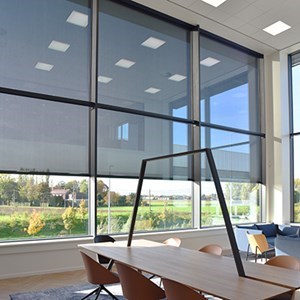Vertical Screens or Drop-arm Awnings: Which Fabric Sunshading Best Suits Your Project?

With summer approaching, sunshading becomes a hot topic once again. Good sunshading not only provides protection from the sun but also contributes to a comfortable indoor climate and energy savings. At DUCO, we offer two main types of fabric sunshading: vertical screens and drop-arm awnings (CAP). But which do you choose when?
In this blog, we compare both systems to help you make the right choice.
How do both systems work?
Vertical screens
Vertical screens are the most traditional type of fabric sunshading. The sunshading fabric moves directly from top to bottom in front of the window. These systems are motorised and are available in various configurations, from basic sunshading to advanced systems that combine ventilation, sunshading and acoustics.
Examples from our range :
DucoScreen Front 150: Sunshading for visible or invisible installation, available in sizes up to 6 metres
DucoScreen Top 120: Invisible behind the cavity wall or visibly installed system
DucoScreen Front 150 Curtain Wall: Specially developed for curtain walls with coupled side guides
DucoScreen Front 95: Compact storm-resistant sunshading ideal for renovation and new build
DucoTwin 120 ZR: Combines natural ventilation and sunshading in one system with acoustic dampening
Drop-arm awnings CAP
Drop-arm awnings work according to a clever two-phase system. The sunshading fabric first drops vertically downwards, then automatically extends at an angle of up to 90°. This unique operation ensures that solar heat doesn't stand a chance, whilst still allowing sufficient natural light inside for a pleasant atmosphere.
Examples from our ranget:
DucoScreen Front 150 CAP : Drop-arm awning that first drops vertically and then extends up to 90° angle
DucoScreen Top 120 CAP : Invisible system with drop-arm function for optimal light-heat balance
DucoTwin 120 ZR CAP : Combines ventilation and drop-arm awning sunshading in one system
Vertical Screens
Advantages:
- Versatility: Suitable for small to very large dimensions (up to 6 metres)
- Storm resistance : All vertical screens have a FIX version and can therefore withstand force 10 winds
- Coupling possibilities: Screens can be coupled together for a uniform façade appearance
- Control options: All fabric sunshading can be motorised. The louvres can be controlled manually or motorised.
- Multifunctional:Can be combined with ventilation (DucoTwin systems)
- Insect screen function: Can be combined with ventilation (DucoTwin systems)
Disadvantages:
- Limited light ingress: When the fabric is fully closed, less natural light enters
- Visibility: Some versions are visible on the façade
Drop-arm awnings CAP
Advantages:
- Optimal light-heat balance: Keeps heat out whilst allowing sufficient light in
- Flexible sunshading: The angle setting gives you precisely the desired amount of sun and shade
- Motorised operation: Always equipped with user-friendly motor control
Disadvantages:
- Wind sensitivity: Maximum resistance to 50 km/h winds (no FIX version possible)
- No coupling possible: Screens cannot be coupled together
- Mandatory wind protection: Must always be equipped with wind protection
- Higher cost: More expensive than vertical screens due to the more complex mechanism
When do you choose which system?
Choose vertical screens when:
You need maximum protection against wind and weather (high-rise, exposed locations)
You want to couple different screens for a uniform façade appearance
You need large dimensions (up to 6 metres)
Choose drop-arm awnings (CAP) when:
You want to retain lots of natural light whilst being protected from heat
You live in a sheltered environment (limited wind loading) (beperkte windbelasting)
You want flexible sunshading (different angle positions)
Your project is in an urban environment with less wind loading
Practical considerations
Ventilation integration
Both systems are available in combination with ventilation via our DucoTwin range. These systems combine natural ventilation with sunshading in one elegant system, ensuring an optimal indoor climate.
Installation and maintenance
Vertical screens are generally easier to install and maintain. Drop-arm awnings require more expertise during installation due to the more complex mechanism.
Fabric choice
For both systems, you can choose from different sunshading fabrics that each have their own characteristics in terms of light transmission, colour and texture.
Our recommendation
There is no universal 'best' choice - it depends entirely on your specific situation. Vertical screens are the safe, versatile choice that works in almost all circumstances. Drop-arm awnings are the premium option for those who want the best of both worlds: effective sunshading without loss of natural light.
Do you have questions about which system best suits your project? Contact us for personalised advice tailored to your needs



.jpg?width=300&height=300&mode=crop)



.png?width=300&height=300&mode=crop)